How you gain the support of others - the process of narrative leadership
Some do it on their own and are successful. Others have to make an effort. But everyone wants it.
Who doesn't want to be heard? Win a new customer? Inspire employees for a new initiative? Support an innovation or cost saving? Bringing companies together after a successful acquisition?
The list is long. Perhaps you are familiar with one situation or another. You just need some acceptance and support from others.
Arguments are not enough
Good logic and reasoning is probably the first thing we all do when we have doubts. Without doubt, we need to convince ourselves and we need reasons to be convinced of an idea or a solution ourselves. Only then can we convince others.
But often all we get is an embarrassed shake of the head and hesitant or insufficient support. Arguments alone are not enough. They help to feed the head. But they don't reach the heart.
Stories without a system are not enough
Stories are a remedy. They arouse emotions, empathy and help to visualize and convey knowledge. They are powerful. Especially in combination with arguments.
But are they enough?
They certainly help to see the issue (idea, solution). At best, they set a thought process in motion. The audience recognizes that it could be something.
Nevertheless, it happens again and again that stories miss their target. There are many reasons for this. Perhaps the most important is that it takes a certain amount of effort to let the new idea or solution into one's life. It is not yet compatible with what you previously thought about yourself and the world.
The process of narrative leadership
What now?
A little anecdote. All marketers have this problem. They send their advertising messages on all channels at all times. They personalize, adapt and hope for positive effects with minimal chances of success. Seth Godin (well-known creative marketing guru) described the phenomenon. And he has formulated a solution and shown a way forward that represents one, if not the only, option in the world of media overstimulation.
He suggested forming a "community". A community that has a common problem and is looking for a solution (for which you by chance have a solution). The way to form and find this community is through storytelling. But not just any story. There are three types. Here he refers to Marshall Ganz, who learned to mobilize communities through many political initiatives. This also applies to Obama. Marshall Ganz has shaped the public narrative and underpinned it with three types of stories:
Why us: Stories about the common problem. Something that triggers the dissonance between the way things are and the way things should be. The stories about it activate those who also have the problem. At least they listen. They are attentive. For those who don't feel addressed, the community is nothing.
Why me: Stories of why you (as an individual) or as an organization got involved with this issue. What is the origin. What things or values guide me? Why do I care about this topic? Can I show and tell my leadership through testimonials from customers?
Innovation and strategy drive me. I've experienced for myself what it's like when the wind blows strongly from the front. Of course, you can't do anything about it, but I don't think that's proactive.
The "why me" stories are the leader's stories. He wants something to change. He wants to inspire the others and help them to solve the common problem.
Back to the three questions:
Why now: It's more neutral stories, figures, data and facts. Or the arguments and logic you have anyway. They show the balance of power and help to understand what happens if you ignore the idea or solution. And what is to be gained by accepting the idea.
But is that enough? Perhaps. In many cases, yes. But finding and telling stories takes time. It can get even better. In the effectiveness of winning others over to the idea.
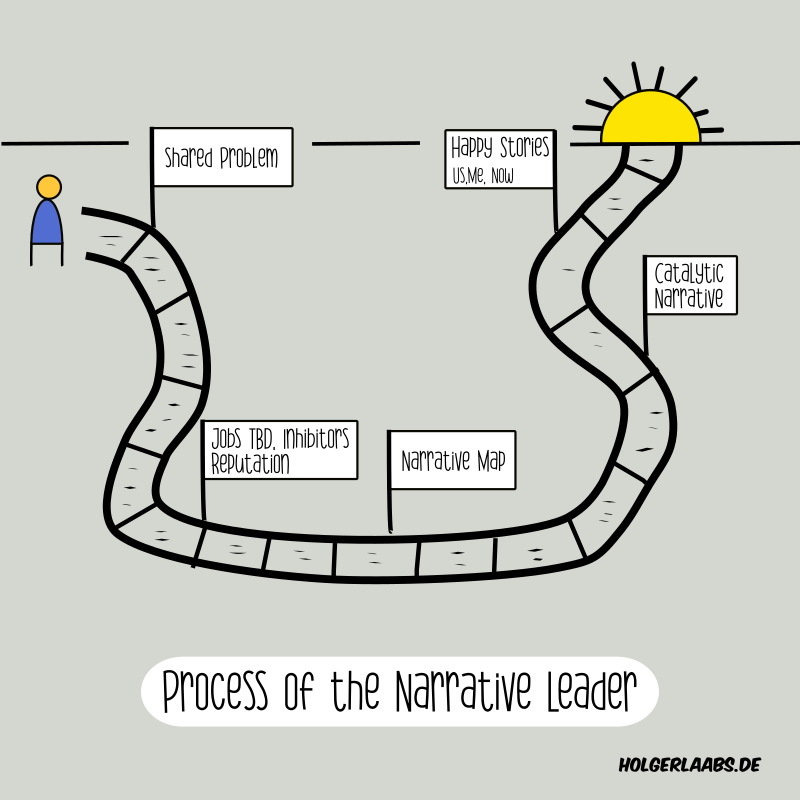
Empathy (Jobs to be done, obstacles and reputation): Clay Christensen has developed the concept of jobs to be done in his books. These are the things that customers need to do. These are the things you have to understand, otherwise you can't develop and sell a solution. The concept is not just the job (like mowing the lawn), but also has an emotional and social component in addition to the functional one. Emotional means how the buyer wants to feel. And who he interacts with or who sees what he does - the social component.
The concept of jobs to be done also looks for influences that pull and push the decision in certain directions. Additionally, you look for the things that keep someone from adopting the idea or solution.
I think you gain something by being a little clearer in some places. Specifically look for obstacles such as inertia, apathy, fear, isolation, self-doubt and ways to overcome them. Also use simple reputation models (with factors such as emotional appeal, products and services, vision and leadership, work environment, financial performance, social responsibility) to assess how reputation changes when someone adopts your idea. Or what you can do to improve the reputation?
This stage of empathy can only be achieved through observation and interviews. They help you understand your audience and draw the narrative map.
Narrative map: The narrative map is all the things that are buzzing around in your audience's heads for and against. Something like "it could be cheaper" or "it's only for techies". These are the spontaneous pros and cons that you have heard from many people. Draw these narratives on a map. Sort them according to the degree of dissemination (widespread or deeply rooted) and cultural depth (long history, linked to emotional events). The strong and deeply rooted narratives must be addressed. Through reinterpretation or with a counter-narrative. But the other narratives are also important and must fit in with your catalytic narrative.
Catalytic narrative: This is the narrative you have developed. It connects the ideas (rejection or approval) of your customers and points in a good direction (for which you offer a solution).
Example. Imagine you are the driving force behind a company acquisition. You know you are gaining scale, additional capabilities and more control over the value chain. But does that help you when you explain this to your old and new employees? They are probably very unsettled. Because the takeover may have an impact on them. Well, if you know that employees respond positively to narratives such as performance improvement, cultural integration, change management, visionary leadership, customer-centric leadership or employee engagement, you will communicate better by building the bridge between your arguments and the positive topics for employees with your catalytic narrative.
Happy stories: The final step is to continually collect and tell stories that fit your catalytic narrative. Keep the sorting according to Marschall Ganz: Why us? Why me? Why now? This structure is good because it creates attention, desire and drive. Only this time, all the stories fit under the umbrella of your catalytic narrative. You can address local specifics, but stay on the same page, consistent and effective. You have increased the relevance of your stories. You reach hearts and deliver good arguments. You say why it is important for you to bring the idea or solution to the world.
Let me end with a little anecdote. I was at an event organized by a tobacco company. The country head was talking about the big shift away from cigarettes to modern electronic solutions. He emphasized that the decision was made by the parent company in the USA. And that it was clear to everyone that the actual core product was disappearing. I asked the country head whether there was any personal history with the US head of the group that was connected to this decision. The answer was that nothing was known. However the decision came about, regulatory pressure, pressure from lobbyists or fear of massive recourse claims, it would be more credible if it had also come from the inner motivation of the Group management. You can do better from now on!
There are 5 spices to team performance. Why?
Patrick Lencioni outlined the 5 dysfunctions of a team in his book
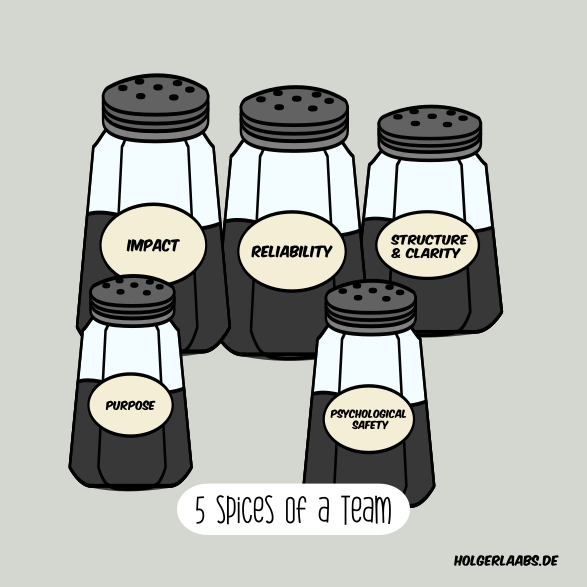
- absence of trust,
- fear of conflict,
- lack of commitment,
- avoidance of accountability,
- inattention to team results.
If you turn these around, you will find the 5 spices
-
Impact: Shows the value the team creates for others (customers, colleagues),
-
Reliability: no excuses, only smooth performance, no unresolved issues
-
Structure and clarity: no guesswork, clear accountability,
-
Purpose: the higher calling, pride in the things you work on, finding meaning in your work,
-
Psychological safety: no hidden agendas, speaking up, daring confrontation to encourage innovation.
Leaders use the spice-shakers often.
What are your team secrets?
Why praise effort, learning, progress?
Why praise effort, learning, progress?
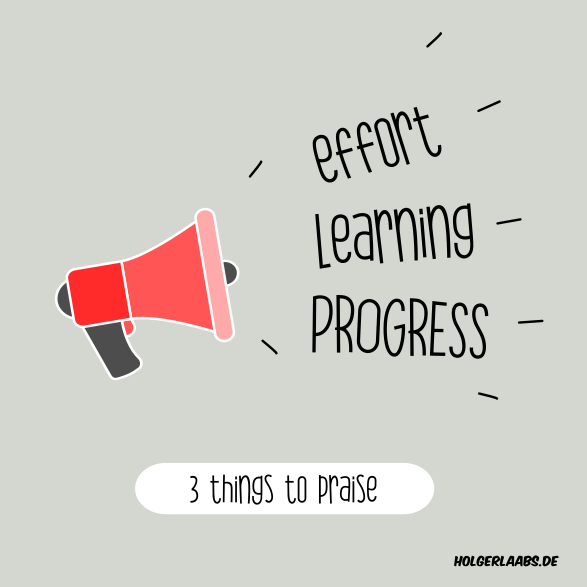
3 things to praise!
Praising effort means recognizing the emotional state of the other person. There is no better way to build a human connection.
Praising learning means recognizing the development of the other person's abilities. Human beings are designed to grow. It makes the other person feel better. Even if the other learns from failure.
Praising progress means moving towards a goal. In this way, you shed light on the other person's impact. And on what is important to you.
What will you praise today?
HOW TO BRING MORE JOY TO WORK?!
The Gallup reports say there could be more joy at work.!

So I looked up what the authors of influential books have to say (Cassie Holmes, Catherine Price, Eric Weiner, Monica C. Parker, Mike Rucker, Katherine Morgan Schafler, Steven Kotler, Matthieu Ricard, Neil Pasricha, Oliver Burkeman, Brene Brown, Shawn Achor, Meik Wiking, Richard H. Thaler, Rick Hanson, Martin E.P. Seligman, Viktor Frankl, Mark Manson, Marie Kondo, Laura Gassner Otting, Michelle Segar, Daniel M. Cable).
Here is a list.
There's something for everyone.
My favorite is curiosity. It is linked to innovation. And I love good design, stories and healthy relationships.
Do you know the 10-5 rule? 10 feet -> smile, 5 feet -> say "hello"
What is your favorite?
How do you engineer joy into your work?
As a leader, does joy for your people play a role in your decisions?
- Seeking awe & be curious every day
- True fun
- Playful presence
- String social connection
- Sense of community
- Pragmatism, balance, social trust
- Simplicity
- Embracing failure
- Search and wonder
- Storytelling
- Striving for wholeness
- Spirituality, religion, mindfulness
- Life & dead experiences
- Profound realizations
- Self compassion
- Non-dualistic thinking
- Collective ambition
- Taming the ego
- Eliminate sources of suffering
- Cultivate compassion
- Find harmony within and without
- Inner work
- Start with happiness
- Eliminate negative thoughts/experiences/feelings
- Vulnerability
- Color
- Nature & movement
- Music arts writing
- Visual arts & architecture/design
- Be opportunities driven
- Broaden your focus
- Align goals with values and priorities
- Teach other skills
- Smile
- Counteract one negative with 3 positives
- 10-5 rule: smile 10 feet - say hello 5 feet
- Sense of purpose
- Preserve freedom to choose
- Stimulate feelings of strength
- Physical activities
- Humor
- Focus on positive emotions
- Engagement
- Positive relationships
- Accomplishments
- Saying yes to life in spite of everything
- Listen to your heart
- Spark joy in your life
- Appreciate what you have
- De-clutter your mind and environment
- Identify and use intrinsic motivations to form habits
- Finding personal meaning
- Prioritize health and well-being
- Not thinking
- Virtues of boredom
Prioritize developing critical thinking skills in their workforce
I was recently asked how important critical thinking is in the age of AI.
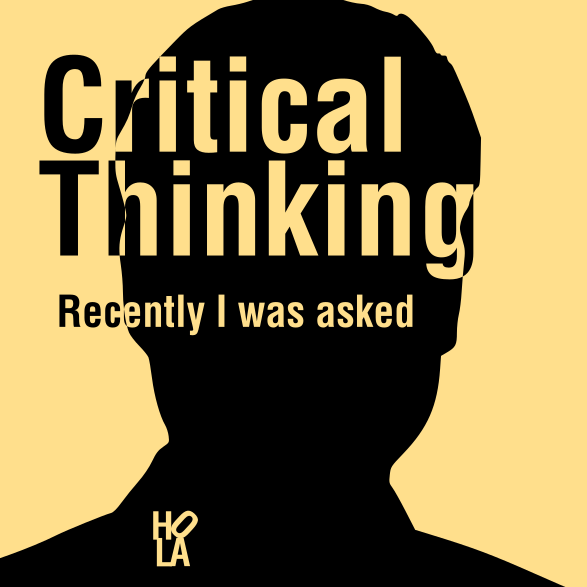
Here is what came to mind...
As AI rapidly advances, it's more important than ever for organizations to prioritize developing critical thinking skills in their workforce.
While AI can be a powerful tool, it's no substitute for the unique insights and problem-solving abilities of the human mind.
Critical thinking is essential navigating the AI revolution:
Asking the right questions:
AI systems are only as good as the data and prompts they are given.
Employees with strong critical thinking skills can ask probing questions to uncover hidden assumptions, identify gaps in data, and ensure AI is being applied appropriately.
Evaluating AI outputs:
The outputs of AI systems must be carefully scrutinized. Critical thinkers can assess the accuracy, relevance and potential biases in AI-generated insights, and make informed decisions about how to act on them.
Identifying AI's limitations:
While AI excels at certain tasks, it still has significant limitations. Employees who think critically can recognize when human judgment is needed to override or complement AI recommendations.
Driving innovation:
Truly innovative ideas often come from challenging assumptions and connecting disparate concepts in novel ways. Cultivating critical thinking fosters the kind of creative problem-solving that allows organizations to stay ahead of the curve.
Adapting to change:
In a rapidly evolving technological landscape, the ability to learn, grow and adapt is paramount. Critical thinking equips employees with the mental agility to navigate uncertainty and continuously improve processes and strategies.
So how can organizations nurture critical thinking in the age of AI?
Here are some ideas:
- Provide training on core critical thinking principles and techniques
- Encourage a culture of questioning, debate and constructive dissent
- Implement processes for systematically evaluating AI systems and their outputs
- Incentivize and reward innovative thinking and problem-solving
- Lead by example - model critical thinking in leadership decisions and communications
The rise of AI is an exciting development, but it does not diminish the value of human intelligence.
In fact, it makes critical thinking skills more important than ever.
By investing in the development of these skills, organizations can harness the power of AI while maintaining a competitive edge.
What are your thoughts on the role of critical thinking in the age of AI?
how to be more curious
Recently I was asked how to be more curious...
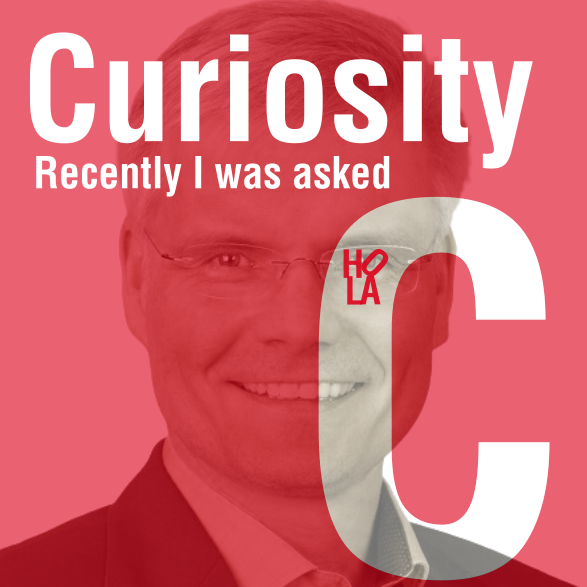
Here is what came to my mind...
- First and foremost, it is a choice. If you don't choose to be, you won't be.
- But the funny thing is, once you get over a small hurdle, you want to be more curious. Whether you try new activities, take different routes, or travel, you expose yourself to new experiences, you naturally pique your curiosity as you seek to understand the unfamiliar.
You might read widely, keep an ideas journal, and explore these curiosities further.
Take up a hobby or skill unrelated to your career where you can learn from the beginner's mindset.
Surround yourself with people who are curious. Their curiosity can be contagious.
- Here is the choice you have to make: Stay curious a little longer. When your mind tells you to move to the next thing (like in a boring conversation), just remind yourself to listen and find an aspect that is new to you that you want to explore.
... and ask more questions.
You most likely find something interesting. 🗝
👉 What are your tricks to stay curious ⁉
I was asked how to be creative
Recently I was asked how to be creative.
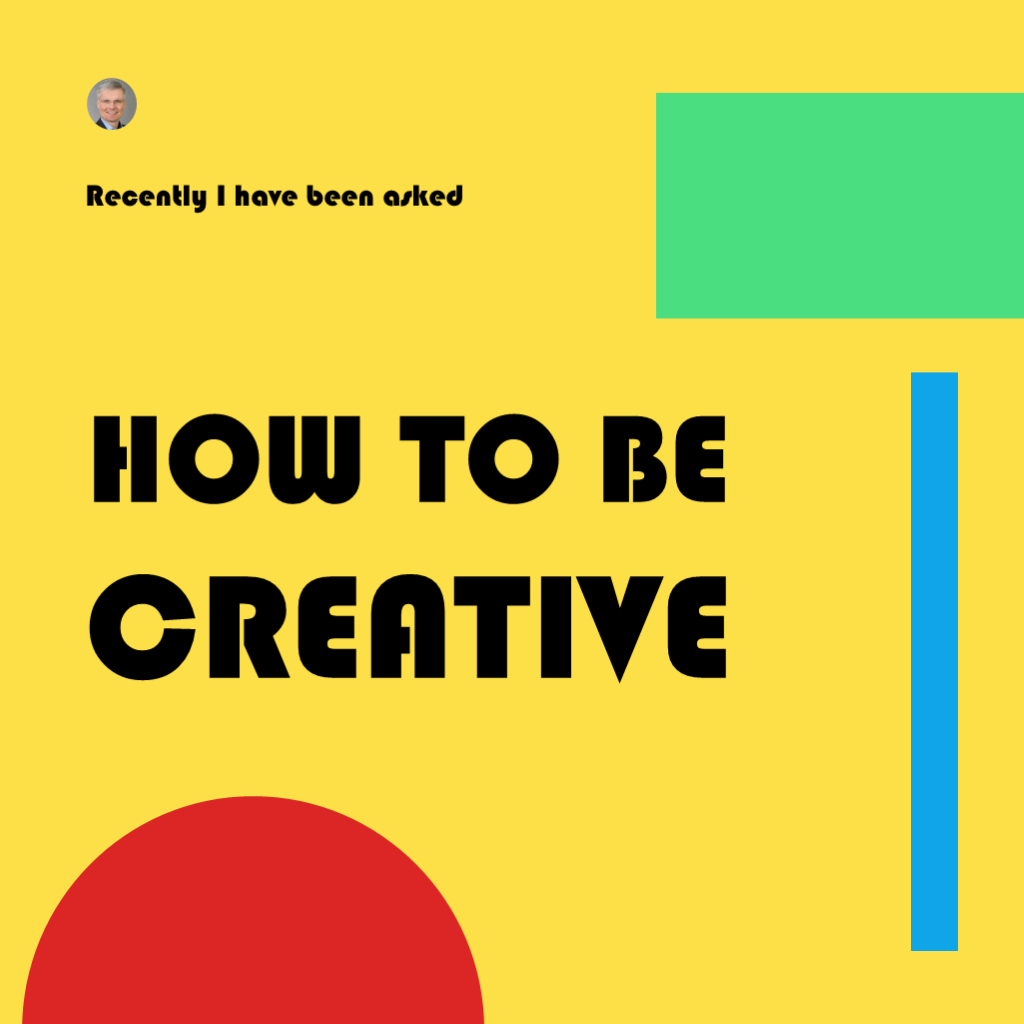
I wasn't sure if I was the best or even a good person to answer that.
But I tried...
"Everyone is creative in a slightly different way. The way people are creative can depend on the situation.
In general, it is certainly a good idea to draw on different sources to allow new associations to produce the necessary spark. This could mean talking to many people, brainstorming with many people with different backgrounds and experiences. And take advantage of different styles of thinking, such as slow and fast thinking.
This may be the default approach for most, but it may not lead to extraordinary results. Being creative is necessary if you want to solve a problem. There is an end to the means, but this in itself can inhibit the creative flow.
Three other points are important.
The first is to question the problem you are trying to solve. Is it the real problem? Sometimes it really helps to look at the environment of the problem, to rethink the goal, to see how others have solved it or how other people see the problem. This leads to a new way of looking at the problem, which may already be the solution. In any case, you will have a better understanding of the challenge you are trying to solve.
The second is that once you have a good understanding of the problem, you can try typical methods like Scamper, Walt Disney, 5W, Fishbone, brainstorming or - writing.... Or you stop the brute force creativity to come up with novel associations of things you are aware of. This means taking a walk or a shower, taking a nap, playing, stimulating your senses. Literally forgetting the problem for a moment. What happens then is that you allow your brain to make the new associations without consciously imposing constraints or judgements on it.
The last is to ask a lot of questions. To err on the side of asking questions. Use your childlike approach and ask lots of why, how and what if questions. They help to unlock more of the creative juice that is inside you.”
So everyone can be creative. If nothing works, take a nap.
The only Cure for the difficulties of being curious
We all find it difficult to stay curious. When you've seen things many times before, you quickly move on to the next one. Being constantly on the lookout for new or interesting things means ignoring the things you've already seen.
An example. If you meet someone and ask them what they do, you might get the answer: “I'm an accountant and I work in a bank." If you're not curious at that moment, the chance of making a connection disappears. It sounds like that's the end of the conversation. You know what he does.
But you might get curious and ask some follow-up questions, such as: How long have you been doing this? How long have you been with the bank? What location do you work at? What made you choose this profession? What are the challenges you face? What drives you every day?
Of course you have to be tactful. And you should listen, so stay curious. Put your own stories aside and use what you hear to answer with a next question.
I asked my daughter what she would ask the musician Taylor Swift if she could talk to her for an hour. She's a big fan of hers. But it was quite difficult to come up with questions. The only way to come up with questions is to stay curious and practice.
The Rewards of Curiosity
Cultivating a sense of curiosity can yield immense personal and societal benefits. On an individual level, curiosity drives us to continually learn, grow, and expand our knowledge and understanding of the world around us. This intellectual exploration can lead to new insights, creative breakthroughs, and innovative solutions to complex problems.
Moreover, curiosity fosters open-mindedness, empathy, and a willingness to consider diverse perspectives, which can enhance our ability to navigate and thrive in an increasingly interconnected and multicultural world. By remaining curious about different cultures, beliefs, and ways of life, we can broaden our horizons and develop a deeper appreciation for the richness of human experience.
On a broader scale, curiosity is the engine that propels scientific discovery, technological advancement, and human progress. Throughout history, the insatiable curiosity of individuals has led to groundbreaking achievements in fields ranging from medicine and engineering to astronomy and computer science, improving the quality of life for countless people around the globe.
Furthermore, a curious mindset can foster a more engaged and participatory society, as individuals are motivated to ask questions, challenge assumptions, and actively seek out information and understanding, rather than passively accepting the status quo.
Ultimately, embracing curiosity can enrich our lives, expand our horizons, and drive positive change in the world around us, making it a profoundly valuable and rewarding trait to cultivate.
Being truly curious can be challenging for several reasons:
The Obstacles to Curiosity
Curiosity often requires stepping out of our comfort zones and embracing the unknown. It demands that we question assumptions, challenge established norms, and confront our own biases and limitations. This process can be unsettling and even threatening to our sense of security and self-assurance.
Cultivating curiosity also requires a significant investment of time, effort, and mental energy. Delving deeply into a subject, exploring new ideas, and seeking out diverse perspectives can be mentally taxing and may conflict with the demands of our daily routines and responsibilities.
Furthermore, curiosity can sometimes lead us down paths that contradict our existing beliefs or worldviews. Confronting information that challenges our deeply held convictions can be psychologically uncomfortable and may trigger defensive reactions, making it tempting to retreat back into the familiar and avoid the dissonance that curiosity can create.
In some social or professional contexts, curiosity may be discouraged or even perceived as a threat. Asking too many probing questions or challenging established practices can be seen as disruptive or disrespectful, leading to social or professional consequences that can inhibit our natural inclination to explore and inquire.
Overcoming these obstacles requires a combination of intellectual humility, open-mindedness, perseverance, and a genuine passion for learning and understanding. Embracing curiosity is a courageous act that demands we confront our fears, biases, and limitations, but it is also a profoundly rewarding endeavor that can lead to personal growth, innovation, and a deeper appreciation for the richness and complexity of the world around us.
Embrace Curiosity
Curiosity is the spark that ignites discovery. Smother it, and you extinguish the flame of progress.
If you don't understand a concept, delve deeper until it becomes clear. If you're unsure about a theory, put it to the test. If an idea seems illogical, explore it from every angle until it makes sense. If a system appears flawless, challenge its limits to uncover potential flaws. If a claim seems dubious, investigate until you uncover the truth. And above all, if someone declares a matter off-limits, let your curiosity be the key that unlocks those doors.
The Pursuit of Knowledge
Never settle for the surface level. Dig beneath to unearth true understanding.
If a subject intrigues you, immerse yourself in its depths. If a problem perplexes you, dissect it until you grasp the solution. If a phenomenon baffles you, study it relentlessly until it unveils its secrets. If a belief is widely accepted, scrutinize it to ensure its validity. If a question arises, pursue the answer with unwavering determination. And most crucially, if someone attempts to restrict your curiosity, let it be the force that shatters those boundaries.
So the is only one thing you can do. Practise and stay curious a little longer, every time.
The Rise of AI and the Erosion of Human Connection
In our rapidly evolving digital age, the integration of artificial intelligence (AI) into various aspects of our lives has brought about unprecedented convenience and efficiency. Be it the selection of products that are displayed at online retailers, options for translating texts or researching and creating texts on any topic. Images and videos are generated. If you believe the leading researchers, artificial intelligence will soon be able to give reasons and not just make claims. AI may also be able to construct and evaluate more analogies more easily than humans ever could.
Artificial intelligence is being used to increase efficiency. Chatbots have proven to be a viable option as a customer interface. Dating apps suggest partners. Communication is gradually being permeated by content created by artificial intelligence.
However, this technological advancement comes with a concerning trade-off: the gradual erosion of human connection and empathy.
The Illusion of Connection
AI-powered virtual assistants, chatbots, and social media algorithms create an illusion of connection by simulating human-like interactions. While these technologies can mimic empathy through predefined responses and emotional cues, they lack the genuine emotional depth and understanding that characterize true human connection.[1] This artificial empathy can desensitize us to the nuances of human interaction, leading to a decline in our ability to empathize and connect with others on a deeper level.
The Decline of Social Skills
As we increasingly rely on AI for communication and social interactions, our social skills may deteriorate. The art of active listening, reading body language, and engaging in meaningful conversations can become undervalued when we are accustomed to the instant gratification and convenience of AI-powered interactions.[3] This erosion of social skills can further exacerbate the disconnect between individuals, making it more challenging to build and maintain meaningful relationships.
The Echo Chamber Effect
AI algorithms are designed to provide personalized content and recommendations based on our preferences and online behavior. While this can be convenient, it also contributes to the creation of echo chambers, where we are exposed to information and viewpoints that align with our existing beliefs and biases.[1] This lack of diverse perspectives can diminish our ability to empathize with others who hold different views, further fragmenting our social fabric.
The Impact on Mental Health
The erosion of human connection and empathy can have profound implications for mental health. Research has shown that strong social connections and empathy are crucial for emotional well-being and resilience.[1] As we become more isolated and disconnected from genuine human interactions, the risk of loneliness, depression, and other mental health issues may increase.
Reclaiming Human Connection
To combat the erosion of human connection and empathy, I recommend the following strategies:
-
Limit excessive reliance on AI interactions. Prioritize face-to-face communication to foster meaningful connections and develop empathy.
-
Strengthen active listening and empathy-building skills through practice exercises. This enhances social abilities and understanding of others' perspectives.
-
Seek out diverse viewpoints through respectful discourse. Exposure to different beliefs cultivates empathy and broadens understanding.
-
Encourage ethical AI development prioritizing human values and promoting empathy as a complement to human interactions.
-
Invest in education emphasizing emotional intelligence, social skills, and the importance of human connection.
-
Nurture creativity and critical thinking by consciously using questions that help build trust, challenge assumptions, stimulate curiosity, and promote deeper and shared understanding.
[3] https://www.ie.edu/insights/articles/human-connection-in-the-age-of-ai/
[4] https://www.linkedin.com/pulse/artificial-empathy-digital-dependency-loneliness-actions-knoop
Why not focus on your strengths?
The Strengths Awakening
"Strengths - they're innate, yet often dormant.
From the old English 'strengthu' meaning 'force' or 'vigor.'
They are your superpowers, far more potent than your weaknesses alone.
This journey isn't about fixing flaws, it's about unleashing brilliance.
It guides you inward, revealing your unique gifts.
It takes you to a place of empowerment and alignment you didn't fully grasp until you arrived.
It's not called self-improvement.
It's called self-actualization. It lets you shine the way the sun shines - radiating the full force of your natural talents and abilities."
As I speak, envision scenes of people operating in their zones of genius. An artist in creative flow. An athlete in peak performance. A leader inspiring their team. A tapestry of human potential fully expressed.
Why focus on strengths?
Flaws drain energy. Strengths renew it.
The world pushes you to improve weaknesses. But leveraging strengths is transformative.
The strength-focused rebel against mediocrity. They don't fix flaws, they maximize gifts. Brilliance, not remediation. Alignment, not adjustment.
Short sentences: Identify your superpowers. Lean into your force. Operate from your zone of genius. Weaknesses remain. But strengths shine brightest. Radiate your natural talents. Actualize your highest self.
The weakness-focused strive for adequacy. But the strength-maximizers achieve excellence. Their gifts uplift and inspire others. Each strength unleashed is a new light illuminating the world.